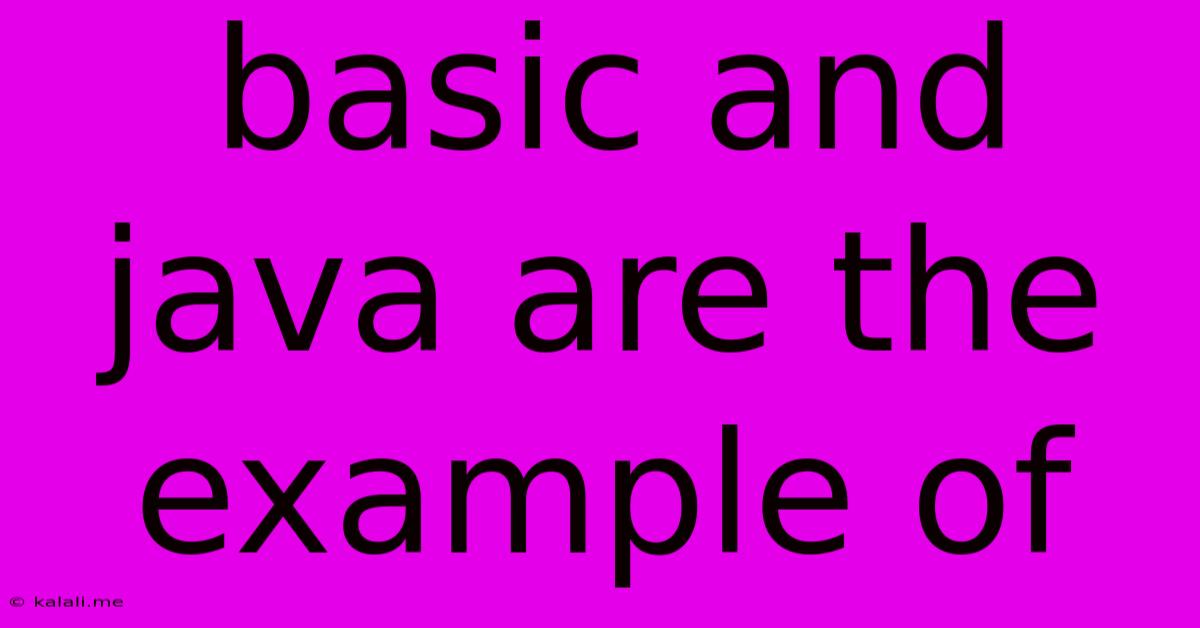Basic And Java Are The Example Of
Kalali
Jun 12, 2025 · 3 min read

Table of Contents
Basic and Java: Examples of Programming Paradigms and Their Applications
Basic and Java, while seemingly disparate at first glance due to their age and application, are excellent examples illustrating different aspects of programming paradigms. They highlight the evolution of programming languages and the diverse approaches developers use to solve problems. This article will delve into what makes them significant examples, exploring their underlying paradigms and key differences.
What are Programming Paradigms?
Before we dive into Basic and Java, it's crucial to understand what programming paradigms are. A programming paradigm is a fundamental style of computer programming, a way of building the structure and elements of computer programs. Different paradigms offer distinct approaches to problem-solving, influencing how code is organized, executed, and understood. Some popular paradigms include:
- Imperative Programming: This focuses on how a program achieves a result by specifying a sequence of commands or statements. Basic is primarily an imperative language.
- Object-Oriented Programming (OOP): This paradigm organizes code around "objects" that contain data (attributes) and methods (functions) that operate on that data. Java is a prime example of an object-oriented language.
- Procedural Programming: This approach structures programs as a collection of procedures or subroutines. Basic shares elements of this paradigm.
Basic: A Legacy of Procedural and Imperative Programming
BASIC (Beginner's All-purpose Symbolic Instruction Code) was designed to be beginner-friendly, emphasizing simplicity and ease of use. Its procedural nature involved breaking down programs into smaller, manageable procedures, promoting modularity—though often to a simpler degree than found in later languages. Its imperative style meant developers directly instructed the computer on each step to achieve a result. While Basic's syntax was straightforward, its limitations became apparent with the rise of more complex software development. However, its legacy lies in its accessibility and its role in introducing many to the world of programming. Different dialects of BASIC existed, evolving over time, some incorporating elements of structured programming to enhance code organization.
Java: A Powerhouse of Object-Oriented Programming
Java, on the other hand, represents a significant leap forward in programming paradigms. Its core is built upon the principles of object-oriented programming (OOP). This means Java programs are organized around classes and objects, encapsulating data and methods within well-defined units. This OOP approach offers several advantages:
- Modularity: Code becomes more reusable and maintainable.
- Encapsulation: Data is protected, enhancing security and preventing unintended access.
- Inheritance: Classes can inherit properties and behaviors from parent classes, promoting code reuse and reducing redundancy.
- Polymorphism: Objects can take on many forms, allowing for flexible and adaptable code.
Key Differences and Their Significance
The differences between Basic and Java exemplify the evolution of programming languages and the shift towards more sophisticated paradigms. Basic's simplicity made it ideal for introductory programming but lacked the scalability and complexity handling capabilities of Java. Java’s OOP approach addresses many of Basic's limitations, making it suitable for large-scale applications and complex software development. This shift reflects the increasing demands for robustness, maintainability, and reusability in modern software development. Moreover, Java's platform independence (write once, run anywhere) further distinguishes it from earlier languages like Basic.
Conclusion:
Basic and Java serve as valuable examples showcasing the spectrum of programming paradigms. Basic’s legacy lies in its accessibility and contribution to early computing education, embodying imperative and procedural approaches. Java, on the other hand, demonstrates the power and benefits of object-oriented programming, influencing a significant portion of modern software development. Understanding these differences is crucial for appreciating the evolution of programming and selecting the right tool for a given task.
Latest Posts
Latest Posts
-
Least Common Multiple Of 27 And 45
Jun 13, 2025
-
What Is The Factor Of 71
Jun 13, 2025
-
10 Is 30 Of What Number
Jun 13, 2025
-
Florida A And M Acceptance Rate
Jun 13, 2025
-
Who Identified Triads Of Elements With Similar Properties
Jun 13, 2025
Related Post
Thank you for visiting our website which covers about Basic And Java Are The Example Of . We hope the information provided has been useful to you. Feel free to contact us if you have any questions or need further assistance. See you next time and don't miss to bookmark.